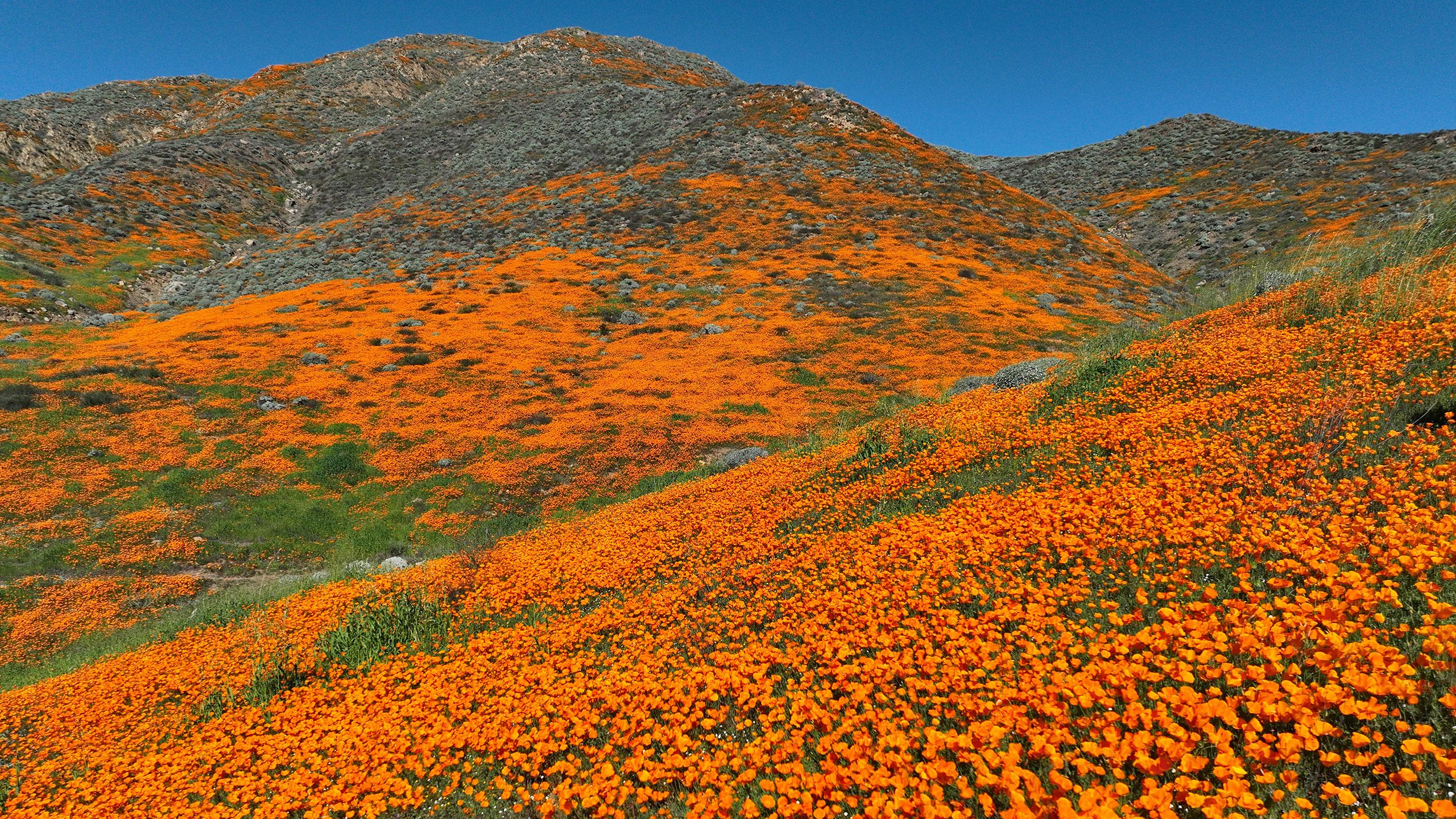Bright pink ocean and rare wildflower super bloom — February’s best science images
The month’s sharpest science shots, selected by Nature’s photo team.

Candyfloss waves. The sea was turned temporarily pink at a beach in San Diego, California, by researchers at the nearby Scripps Institution of Oceanography, who added a non-toxic pink dye to the water to study how plumes of fresh water flowing out into the sea interact with breaking waves. “It’s a really unique experiment,” said Sarah Giddings, a coastal oceanographer at Scripps, in a press statement. “We will combine results from this experiment with an older field study and computer models that will allow us to make progress on understanding how these plumes spread.”

Calming comet. Comet C/2022 E3 (ZTF) was visible from Earth for the first time in around 50,000 years, making its closest approach to Earth on 1 February. The comet — seen here above the slopes of Mount Etna in Sicily, Italy — has a greenish glow owing to the effects of sunlight on some of the gases streaming off its surface. The comet comes from the Oort cloud, a layer of icy objects on the outskirts of the Solar System.

Credit: Juan Gonzalez/Reuters
Credit: Juan Gonzalez/Reuters
Deer danger. A pile of logs is reduced to glowing embers by a wildfire in Santa Juana in Chile. Out-of-control forest fires during Feburary in the region have led to dozens of deaths, destroyed homes and injured wildlife including woodland marsupials and pudus — the world’s smallest deer. Authorities have warned that persistent hot, dry weather could exacerbate the blazes.
Credit: NAOJ & Asahi Shimbun (this video has no sound)
Credit: NAOJ & Asahi Shimbun (this video has no sound)
Laser lines. Star-watchers in Hawaii were initially baffled by a series of mysterious green lights shooting through the night sky on 28 January. The vertical lines appeared in livestream footage from the Subaru-Asahi Star Camera on Maunakea. The National Astronomical Observatory of Japan, which co-owns the camera, later tweeted that the lights probably came from the Chinese atmosphere-monitoring satellite Daqi which uses laser beams for mapping and measuring pollutants, fine particles and carbon dioxide.

Credit: Christoph Liedtke
Credit: Christoph Liedtke
No croak. The newly discovered Ukaguru spiny-throated reed frog (Hyperolius ukaguruensis) does not croak, ribbit or make any other sounds to communicate to its froggy friends. As its name suggests, the silent frog has small spines on the outside of its throat. “The male frogs don’t call like most other frogs do,” said Lucinda Lawson, a conservation biologist at the University of Cincinnati in Ohio. “We think they may use the spines as something like Braille for species recognition.” Researchers found the voiceless amphibian in Tanzania’s Ukaguru mountains while searching for a different species of frog — the beautiful tree toad (Churamiti maridadi), which is feared to be extinct.

Rainbow pollen. This image of a single grain of pollen from a Mimulus plant shows its unusual pattern of spiralling apertures. The pollen has been stained with a dye called fuchsin and viewed using green light under a confocal microscope. Many slices were imaged and stacked to get this 3D reconstruction, which has been colour-coded on the basis of depth (with red closest to the lens, and blue furthest away).

Super bloom. California poppies (Eschscholzia californica) and other wildflowers carpet the slopes of Walker Canyon, near Lake Elsinore, California, in a spectacular event known as a super bloom. These are fairly rare because they can happen only under specific conditions — heavy winter rainfall after several years of drought, which kill off grasses and weeds that take up nutrients. The most recent super bloom in Walker Canyon happened in 2019.

A very old boy. Thirty-year-old Bobi has been named the world’s oldest-ever dog. He is a purebred rafeiro do Alentejo, a Portuguese breed that normally has a lifespan of 12–14 years. Bobi lives in Portugal with his owners, who attribute his long life to a diet of unseasoned human food, having space to roam and living in a calm, peaceful environment.

Credit: Shane Gross/UPY 2023
Credit: Shane Gross/UPY 2023
Ugly babies. This snap showing a shoal of embryonic plainfin midshipman (Porichthys notatus) still attached to their yolk sacs was a winner at the Underwater Photographer of the Year 2023 awards. Photojournalist Shane Gross says he was drawn to the fish because of their unusual life cycles. “The males sing to attract females and she will lay as many eggs as his singing deserves before moving on to the next singer,” he explains. “The male has a chance to fertilize the eggs, but only if he is not beaten to the punch by a sneaker male who looks like a female. The singer male will then guard the nest never knowing the kids may not be his.”





Credit: Oguz Yeter/Anadolu Agency/Getty
Credit: Oguz Yeter/Anadolu Agency/Getty

Credit: Muhammed Said/Anadolu Agency/Getty
Credit: Muhammed Said/Anadolu Agency/Getty

Credit: Adem Altan/AFP/Getty
Credit: Adem Altan/AFP/Getty

Credit: Burak Kara/Getty
Credit: Burak Kara/Getty
Search for survivors. A 7.8-magnitude earthquake hit southeastern Turkey and parts of Syria on 6 February. Tens of thousands of people have lost their lives, and the quake and its aftershocks have flattened buildings and sent rescuers digging through debris to find survivors. In northwest Syria, health systems — already weakened by more than a decade of war — have been overwhelmed with thousands of injured people. Outside urban areas, the disaster’s scars on the landscape can be seen — in Tepehan, Turkey, a 50-metre-deep fissure now rips through the middle of an olive grove, dividing it in two. Researchers say people need to brace themselves for yet more quakes and aftershocks, as well as deteriorating weather.